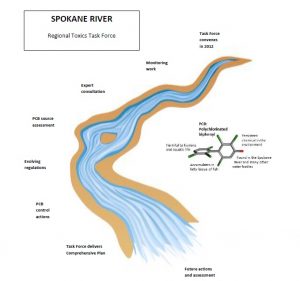FOR IMMEDIATE RELEASE: January 30, 2017
New comprehensive plan for the Spokane River guides actions for reducing PCBs
Spokane, WA – A positive step toward a cleaner Spokane River was quietly recorded this past December. The Spokane River Regional Toxics Task Force (Task Force) released a comprehensive plan that identifies a variety of actions that could prevent more polychlorinated biphenyls (PCBs) from polluting the Spokane River. PCBs are a probable human carcinogen that can build up in people and fish. The entire plan can be viewed on the Task Force website.
The plan was developed to guide projects in Idaho and Washington that will identify, reduce and eliminate PCB sources to the river. It lays out findings from several years of studies that measured the extent of PCB pollution in various sections of the river and identified sources of PCBs and how they reach the river.
PCBs remain in the environment and build up over time in fish, animals and people. The Washington Department of Health advises people to limit the amount of fish they consume from the river over many years for most species because of PCBs. That’s why finding even tiny amounts of these chemicals in the Spokane River requires action.
The plan also specifies projects and practices that, if applied, will reduce PCBs in the river. Examples include, measures to capture polluted stormwater through green building design and state-of-the-art treatment technology for industrial and municipal dischargers to filter PCBs out of their wastewater before it enters the river.
PCB control actions include, but are not limited to:
- wastewater treatment
- known site remediation
- stormwater controls
- low impact development (LID)
- purchasing standards for products known to contain PCBs
- support of green chemistry alternatives
- regulatory rulemaking to reduce origin of PCBs
- building demolition and renovation control
- education efforts to help the public understand the scope of PCB pollution and reduction actions
The Task Force will evaluate the success of the effort by tracking project milestones and assessing effectiveness of individual actions to protect the river. The Task Force is a diverse body of stakeholders (dischargers, environmental groups, and agencies) formed in 2012 to develop a plan to bring the Spokane River into compliance with applicable water quality standards for PCBs. This plan represents conclusions reached through data collection, evolving technology, national expert consultation and deliberation among Task Force members.
Background
The Spokane River begins in northern Idaho at the outlet of Coeur d’Alene Lake and flows west 112 miles to the Columbia River. Sections of the Spokane River and Lake Spokane have been placed on Washington’s EPA-approved 303(d) list of impaired waters for polychlorinated biphenyls (PCBs). The impairments are based on concentrations of PCBs measured in fish tissue that exceeded a fish tissue equivalent concentration for applicable water quality standards.
PCBs are a man-made chemical produced for industrial use by Monsanto from the late 1930s until they were largely banned as an environmental and human health hazard in 1979. Because they resist breaking down in the environment, PCBs persist in soils, surface water, and groundwater. PCBs do not attach to water but readily attach to lipids (fats) and carbon. As a result, they accumulate in aquatic organisms and magnify in concentration as they go higher up the food chain. This means that apex consumers (such as osprey or humans) that consume fish or other aquatic organisms can accumulate large concentrations of PCBs over time, resulting in magnified health risks. According to the U.S. Department of Health and Human Services, individuals who are continually exposed to PCBs are at increased risk of developing cancer and experiencing toxic effects on bodily systems.
PCBs are still allowed when inadvertently produced, such as during the manufacture of certain pigments, inks and dyes that are then used in thousands of products. Because PCBs resist breaking down in the environment, both older, legacy PCBs and newer, inadvertent PCBs still show up in residential and industrial wastewater, stormwater, groundwater and soils and ultimately reach our waterways.
CONTACTS:
Tom Agnew, Liberty Lake Sewer and Water District, 509-255-6686
John Beacham, City of Post Falls, 208-777-9857
Brooke Beeler, WA Department of Ecology, 509-329-3478
Galen Buterbaugh, Lake Spokane Association, 509-465-2289
Adrienne Cronebaugh, Kootenai Environmental Alliance, 208-667-9093
Chris Donley, WA Department of Fish and Wildlife, 509-892-1001 Ext 307
Don Keil, City of Coeur d’Alene, 208-769-228
Doug Krapas, Inland Empire Paper, 509-924-1911
Greg Lahti, WA Department of Transportation, 509-324-6138
Mike LaScuola, Spokane Regional Health District, 509-324-1574
Bud Leber, Kaiser Aluminum, 509-927-6554
Dave McBride, WA Department of Health, 360-236-3176
Dave Moss, Spokane County, 509-477-7572
Mike Petersen, The Lands Council, 509-209-2408
Dan Redline, Idaho Department of Environmental Quality, 208-769-1422
Elizabeth Schoedel, City of Spokane, 509-625-6232
Jerry White, Riverkeeper, 509-835-5211

